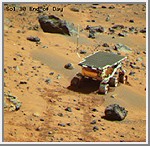| Main Menu | |
|
Home/News Old News The Game Doom History id History Creators Awards Bad guys Weapons Ammo Items Characters Parameters Cheat Shareware Games Alpha & Beta Doom Ultimate Doom Doom 2 Final Doom Doom 3 PSX Doom SNES Doom Doom 64 GBA Doom Jaguar Doom 3DO Doom 32X Doom Saturn Doom Doom 95 2600 Doom Collectors Ed. id Anthology Wad Sets Master Levels Lost Episodes Places Mars Phobos Deimos Earth Media Images Sightings Doom Music Communication Doom Quiz Contribute Links E-Mail teapot |
Mars
 Before Doom starts the stories goes that you were transferred to Mars for assaulting a superior officer for ordering his soldiers to fire at civilians, once you hear destress signals from Phobos you teleport there to help out. Then the game begins. Paul Jaquays indicated that part of Doom 3 might take place on Mars.
The northern hemisphere consists of vast plains on its surface and is much younger and lower in elevation than the southern hemisphere which is covered in accent craters. Space craft that have successfully visited Mars include : Mariner 4, Mariner 6, Mariner 7, Mariner 9, Mars 2, Phobos 2, Viking 1, Viking 2, Mars Observer and Mars Pathfinder part of the Mars Surveyor Program. The Hubble Space Telescope has taken a number of pictures. Mariner 4 was launched after Mariner 3 failed when its protective shroud failed to eject as it went into space so it couldn't collect the suns power with its solar panels. Mariner 4 reached mars in 1964 and took the first close-ups of Mars, after which scientists claimed that Mars was both biologically and geologically dead. Mariner 6 was launched on Feb. 24, 1969 and did a fly by of Mars taking a number of photographs using a visual imager, ultraviolet spectrometer, and temperature sensors. Mariner 7 was launched on Mar. 27, 1969 and has a mission similar to Mariner 6. Together Mariner 6 and 7 returned 143 as they aproached Mars and 58 as they flew by it. Mariner 9 was launched after another failed mission, Mariner 8 that failed to launch. Mariner 9 in 1971 was the first craft to orbit the planet and showed volcainos and caynons never before seen. Mars 2 was Launched on May 19, 1971 was the first craft to deploy a lander successfully on Mars it measured the gas constituents, the pressure conditions in the gas envelope (how pressure varies with altitude) and recorded the temperatures of the night side of Mars. Phobos 2 was launched on July 12, 1988, it went into orbit of Mars and did studies of the surface, atmosphere, and magnetic field. Viking 1 launched on Aug. 20, 1975 it had a lander that made the first soft landing on Mars, it was equipped with a number of atmospheric sensors and searched for Martian micro-organisms. It also took the first surface pictures of Mars and revealed that it's sky is a red-pink colour not blue as previously thought. Viking 2 was launched on Sept. 9, 1975 as with Viking 1, Viking 2 had a lander that made a soft landing and did similar studies of the Planet. Together Viking 1 and 2 returned more than 4,500 pictures from the landers and 51,539 from the space craft, which where used to map 97% of the surface of Mars. Mars Pathfinder was launched on December 4 1996 and landed successfully on Mars on 1997 July 4, it has a lander with a veichel (Rover) inside that can perform various tests on the planet. Hubble Space Telescope was launched in April 1990 and after having problems with its primary lens was fixed in December 1993, it is capable of taking high quality images in space, being outside the earth atmosphere gives it a better range with out the interference. Hubble took sever images of Mars showing that it was much colder and drier than the Viking craft showed during their missions. Bibliography Web: ·Mars ·Mars Spacecraft Book: ·The Hamlyn Encyclopedia of Stars & Planets, by Antonin Rükl, edited by Storm Dunlop, Published by The Hamlyn Publishing Group Limited, a division of the Octopus Publishing Group PLC, 1988. ·Geographica, Published by Gordon Cheers and Random House Australia, 1999 |

